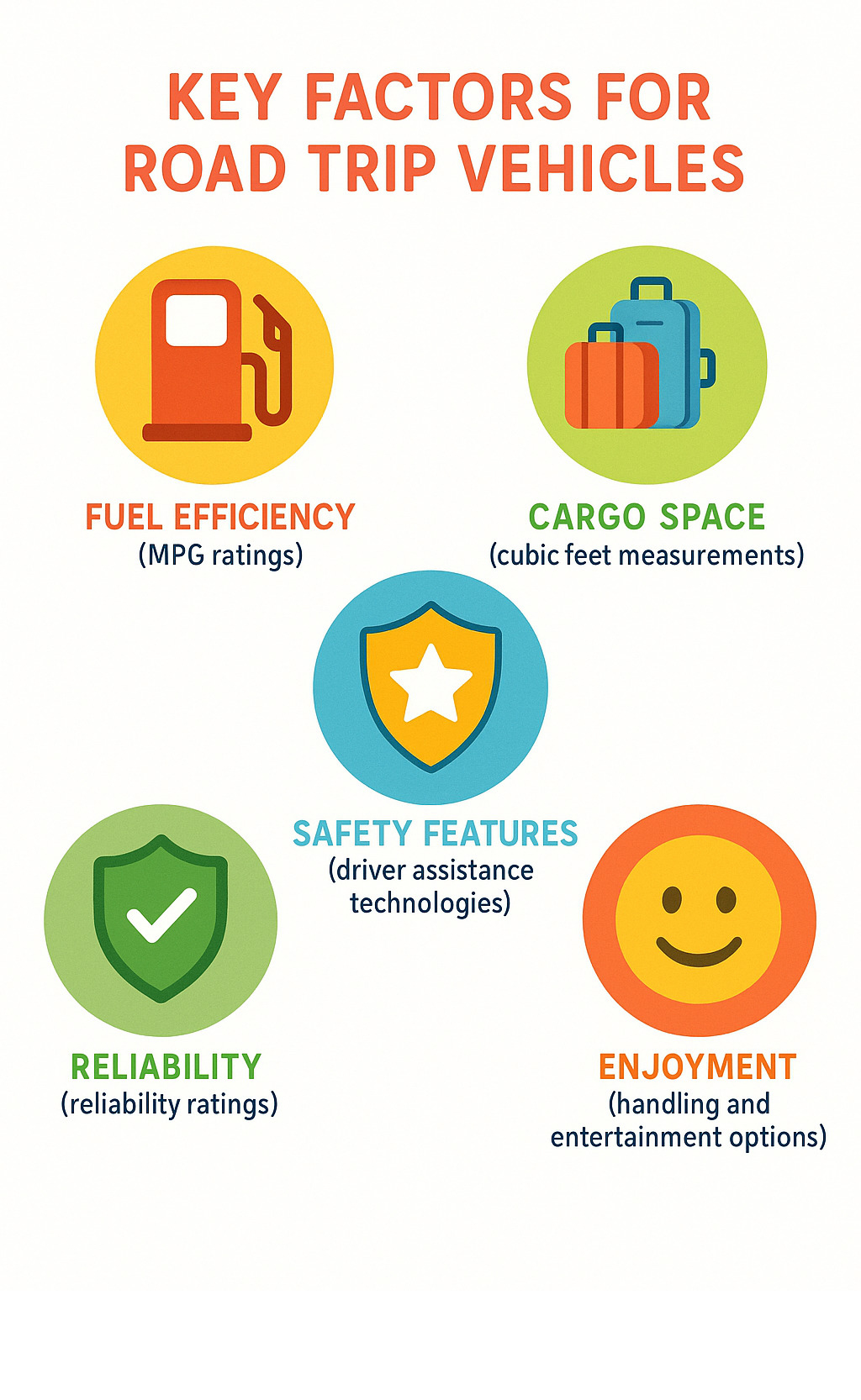Best cars for road trips: 7 Top Picks for Ultimate Comfort 2025
Finding Your Perfect Road Trip Companion
Best cars for road trips combine comfort, reliability, fuel efficiency, and ample cargo space. Here’s a quick overview of the top contenders:
- Honda CR-V Hybrid – 43 mpg city/36 mpg highway, 75.8 cubic feet of cargo space
- Subaru Outback – Standard AWD, up to 75.7 cubic feet of cargo space
- Kia Telluride – Up to 28 mpg highway, spacious three-row seating
- Toyota Highlander Hybrid – 35 mpg combined, smooth ride quality
- Chrysler Pacifica Hybrid – 32 miles of all-electric range, family-friendly features
The great American road trip is a time-honored tradition that transforms the journey into the destination. Whether you’re cruising along coastal highways, traversing mountain passes, or exploring national parks, the vehicle you choose can make or break your experience.
As AAA reports that 38.4 million Americans traveled by car over Memorial Day weekend alone (the highest since 2000), picking the right vehicle matters more than ever. Your road trip car needs to balance comfort for those long stretches of highway, reliability to avoid unwanted trips at repair shops, and enough space for both passengers and the inevitable overpacking.
“The road trip is a time-honored tradition in American culture, to not only get from point A to point B, but to experience all the beauty and oddities along the way,” notes one travel expert. And the right vehicle makes those oddities all the more accessible.
When selecting the best cars for road trips, consider what automotive journalists call the “six pillars”: fuel efficiency, comfort, cargo space, reliability, safety features, and enjoyment. The perfect balance of these elements varies based on your destination, passenger count, and how much gear you’re hauling.

The Road-Trip Car Buying Checklist
Let’s face it – finding the perfect road trip vehicle is a bit like dating. You need compatibility on multiple levels, and what works for one journey might not work for another. Before you commit to your next automotive companion, let’s walk through what truly matters for those long-haul trips.
Think about the terrain you’ll be conquering. Will you be gliding along smooth interstate highways or venturing down those Instagram-worthy gravel roads to hidden waterfalls? As one wise road warrior on our forums noted, “Where will you be road tripping?” This simple question determines whether you need something with off-road chops like a Jeep Grand Cherokee or a highway-optimized cruiser like a Honda Civic.
Your passenger count dramatically shapes your vehicle needs. Solo triprs might relish the freedom of a compact SUV, while couples often find midsize crossovers perfect. One passionate traveler described the Mazda MX-5 as “the definitive two-seat convertible for couples who want to experience sights, sounds and smells on the road.” Meanwhile, families with kids (and their seemingly endless gear) might find salvation in a three-row SUV or the ultimate road trip solution – the modern minivan.
Speaking of gear – cargo volume matters more than you think. We’ve all been there: everything fits perfectly until you impulse-buy that quirky roadside souvenir or decide you absolutely need that extra cooler. The Volkswagen Atlas gives you a generous 55 cubic feet with its third row folded, while the Honda CR-V flexes with an impressive 75.8 cubic feet when you need it most.
Let’s talk about the elephant in the room – fuel economy. With gas stations “continuing to take all our money” (as one of our automotive journalists perfectly put it), how much your vehicle drinks matters. The best cars for road trips often excel here, with options like the Honda CR-V Hybrid achieving up to 43 mpg combined. For those who prefer diesel, the Silverado 1500 Duramax delivers a surprising 28-30 mpg on those long highway stretches.
Modern safety technology has transformed road tripping from exhausting to enjoyable. Look for adaptive cruise control that maintains your speed and distance from vehicles ahead, lane-keeping assistance that gently nudges you back when your attention drifts, and blind-spot monitoring that watches your back when you can’t. These features aren’t luxury anymore – they’re road trip essentials.
Beyond safety, driver-assist aids like Ford’s BlueCruise hands-free driving system can transform mundane highway miles. These systems handle steering, braking, and acceleration on pre-mapped highways, allowing you to arrive at your destination less fatigued and more ready to explore.
Never underestimate seating ergonomics. As one veteran road-tripper wisely observed, “After 8 hours, you’ll know if your seats are truly comfortable.” Features that seem like luxuries – adjustable lumbar support, ventilated seats, proper thigh support – become priceless when you’re watching the miles tick by. Your back will thank you.
If your trips include toys like a camper, boat, or ATV, towing capacity jumps to the top of your checklist. The Chevrolet Tahoe flexes with up to 7,900 pounds of towing muscle, while the Ram 1500 dominates with an impressive 11,580 pounds when properly equipped. Just remember that towing significantly impacts your fuel economy.
Finally, consider weather readiness. All-wheel drive isn’t just for off-roading enthusiasts – it provides peace of mind when unexpected weather tries to derail your plans. Many a vacation has been saved by the Subaru Outback’s standard AWD system when sudden snowfall or muddy conditions appear out of nowhere.
| Vehicle Type | Average Cargo Space | Average Highway MPG | Passenger Capacity | Typical Starting Price |
|---|---|---|---|---|
| Midsize SUV | 65-75 cubic feet | 25-30 mpg | 5 | $35,000 |
| Minivan | 80-90 cubic feet | 28-32 mpg | 7-8 | $33,000 |
| Full-size SUV | 90+ cubic feet | 20-25 mpg | 7-8 | $50,000+ |
| Wagon | 60-75 cubic feet | 30-35 mpg | 5 | $30,000 |
| Crossover | 55-65 cubic feet | 28-33 mpg | 5 | $28,000 |
As you weigh these factors, the best cars for road trips balance all these elements rather than excelling at just one. Your perfect road trip companion is out there – it just might take a little matchmaking to find it.
Best Cars for Road Trips: 7 Vehicles That Ace Long Miles
When it comes to finding your perfect road trip companion, certain vehicles rise above the rest. After evaluating hundreds of options, these seven standouts combine the essential ingredients for memorable journeys: versatility, reliability, spacious cabins, modern infotainment, impressive fuel economy, and advanced safety features. Let’s explore what makes each one special.
Subaru Outback – Trip Meets Efficiency
The Subaru Outback has earned its legendary status among best cars for road trips by masterfully blending practicality with trip-ready capability. With standard all-wheel drive and a generous 8.7 inches of ground clearance, this versatile wagon confidently handles everything from smooth highways to those tempting dirt roads leading to hidden campsites.

What makes the Outback truly special is how it delivers SUV capabilities in a more efficient package. With up to 75.7 cubic feet of cargo space and integrated roof rails, it swallows camping gear, coolers, and luggage with ease. The cabin stays remarkably quiet on long stretches, letting you enjoy conversations or your favorite road trip playlist.
One Outback owner shared: “My Outback delivered about 32 mpg under ideal conditions while handling rough dirt roads with ease. It discourages break-ins too, since it looks more utilitarian than flashy.” This understated capability explains why so many outdoor enthusiasts remain fiercely loyal to the model.
The available turbocharged engine provides welcome punch for mountain passes, while the standard EyeSight driver assistance technology helps keep fatigue at bay during those long interstate stretches. Starting around $30,000, it delivers exceptional value for adventurous souls.
Honda CR-V Hybrid – Fuel-Sipper Among the Best Cars for Road Trips
If you’d rather spend money on experiences than fuel, the Honda CR-V Hybrid stands tall among the best cars for road trips. This midsize crossover achieves an impressive 43 mpg city and 36 mpg highway, dramatically stretching your travel budget for more memorable stops along the way.
Real-world efficiency often exceeds even these impressive ratings. Managing Editor Joe Bruzek noted: “In our 200-mile mixed highway and rural test, the Honda Accord Hybrid Sport-L achieved 51.3 mpg versus its EPA estimate of 44 mpg.” The CR-V Hybrid uses similar technology, frequently delivering better-than-advertised economy.
Beyond just saving at the pump, the CR-V Hybrid offers a cavernous 75.8 cubic feet of cargo space with the rear seats folded—plenty for all your road trip essentials. Its well-insulated cabin keeps highway noise at bay, while the hybrid system provides smooth, responsive power whenever you need it.
“It perfectly balances comfort, practicality, and fuel efficiency,” notes one automotive reviewer. The rear seats even recline, making backseat passengers almost as comfortable as those up front—a true rarity and blessing on long drives.
Honda Sensing safety technologies come standard, including adaptive cruise control that maintains a set distance from vehicles ahead—perfect for reducing mental fatigue during those long interstate stretches where the miles seem to blend together.
Kia Telluride – Big Comfort, Small Gas-Station Stops
The Kia Telluride has quickly established itself as one of the best cars for road trips for larger families or groups who refuse to sacrifice comfort. This three-row SUV combines premium features with surprising efficiency, achieving up to 28 mpg on the highway despite its generous proportions.
The Telluride’s thoughtfully designed interior sets it apart from competitors. Available second-row captain’s chairs provide first-class comfort with adjustable armrests and the ability to recline. Even the third row offers adequate space for adults—something rarely found in this segment and invaluable when everyone needs their personal space on day three of your journey.
Highway manners are impeccable. The suspension absorbs road imperfections without feeling floaty, and the cabin stays remarkably quiet even at interstate speeds. The 10.25-inch touchscreen infotainment system includes navigation and smartphone integration, while USB ports throughout all three rows keep everyone’s devices charged—preventing those dreaded “my phone is dead” complaints.
One Telluride owner described their cross-country trip: “We drove from Charlotte to Austin with our Jack Russell mix, and the Telluride averaged 30 mpg while providing plenty of space for our belongings. The dog had his own section in the back, and we never felt cramped.”
Starting around $33,000 and backed by Kia’s excellent 10-year/100,000-mile powertrain warranty, the Telluride offers tremendous value and peace of mind for families who love to explore.
Chrysler Pacifica Hybrid – The Minivan Reinvented
Let’s be honest—minivans might not be the coolest vehicles in the parking lot, but the Chrysler Pacifica Hybrid might just change your mind. This technological powerhouse ranks among the best cars for road trips for families by combining unprecedented efficiency with best practicality.

This plug-in hybrid can travel approximately 32 miles on electric power alone before switching to hybrid operation, where it achieves around 30 mpg combined. That electric-only range is perfect for daily sightseeing at your destination without burning a drop of fuel.
“It’s hard to beat a minivan for comfort and convenience on a long road trip,” notes one automotive expert, and the Pacifica Hybrid proves why. Its sliding doors make loading passengers and gear effortless in tight parking spots, while the Stow ‘n Go seating system (partially available in the hybrid) creates a flat load floor when maximum cargo space is needed.
Families with children particularly appreciate the available rear entertainment system with dual 10-inch touchscreens. One parent shared, “We drove from Washington to Flathead Lake, and the kids were so engaged with the entertainment system that we didn’t hear a single ‘are we there yet?'” That alone might be worth the price of admission.
Starting around $50,000 before federal tax incentives, the Pacifica Hybrid isn’t cheap, but its combination of efficiency, space, and family-friendly features makes it an investment in countless stress-free miles.
Chevrolet Tahoe – Towing King of the Interstate
Some road trips require bringing serious gear along for the ride. For those trips, the Chevrolet Tahoe stands among the best cars for road trips involving towing or maximum cargo capacity.
“Generations of Americans have taken road trips in a Chevrolet Suburban,” notes one automotive historian, and the latest Tahoe continues this tradition with thoroughly modern technology and improved efficiency. It can tow up to 7,900 pounds when properly equipped—perfect for bringing along boats, campers, or trailers that transform a simple road trip into an epic trip.
What’s particularly impressive is the available 3.0-liter Duramax diesel engine, which delivers up to 28 mpg on the highway—remarkable efficiency for a vehicle of this size. One owner noted, “The Silverado 1500 with the Duramax diesel consistently returns 28-30 mpg on highway trips, and the Tahoe uses the same powertrain.”
Inside, the Tahoe offers three spacious rows and up to 122.9 cubic feet of cargo space with the rear seats folded. The independent rear suspension provides a dramatically smoother ride than previous generations, while available air suspension can automatically level the vehicle when loaded or towing—a feature you’ll appreciate when fully packed.
Tech features include a 10.2-inch touchscreen, wireless Apple CarPlay and Android Auto, and up to 10 USB ports throughout the cabin. For families who need maximum space and capability, the Tahoe delivers comfort and confidence in equal measure.
Tesla Model 3 – Electric Miles of Smiles
Electric vehicles have transformed from range-anxiety-inducing experiments to legitimate contenders for the title of best cars for road trips, and the Tesla Model 3 leads this revolution. With up to 341 miles of range per charge and access to Tesla’s extensive Boostr network, electric road tripping isn’t just possible—it’s becoming the preferred option for many travelers.
Joe Bruzek, who owned a Tesla Model Y for 2.5 years, reported: “We found it easy to road-trip, even in frigid temperatures when range plummets, because of its onboard trip-planning tool and Tesla’s numerous on-the-road Boostrs.” The Model 3 benefits from these same advantages, with an even more efficient aerodynamic profile that extends range further.
The Model 3’s minimalist interior creates a calming environment for long drives, with virtually all functions controlled through the central 15-inch touchscreen. The front trunk (frunk) adds extra storage space for items you want to keep separate from your main luggage.
One of the Model 3’s secret weapons for road trips is its Autopilot system, which combines adaptive cruise control with lane-centering to reduce driver fatigue on highways. While drivers must remain attentive, the system handles much of the moment-to-moment work of highway driving, leaving you fresher at day’s end.
The whisper-quiet cabin makes conversation easy and improves the premium audio system’s performance. Tesla’s Boostr network allows for charging from 15% to 80% in approximately 40 minutes—just enough time for a meal break. The onboard navigation system automatically plans charging stops and estimates arrival times with remaining battery percentage.
Starting around $39,000, the Model 3 represents the new generation of road trip vehicles that combine sustainability with genuine long-distance travel capabilities.
Ford Mustang Mach-E – Style & Space in an EV Crossover
Blending the spirit of America’s iconic pony car with crossover practicality, the Ford Mustang Mach-E earns its place among the best cars for road trips for environmentally conscious travelers who refuse to compromise on style or space.
With up to 59.7 cubic feet of cargo space, including a front trunk for smaller items, the Mach-E offers surprising utility for an electric vehicle with such dynamic styling. Extended-range models can travel up to 300 miles on a charge, making interstate travel entirely feasible with strategic charging stops.
What sets the Mach-E apart for road trips is Ford’s BlueCruise hands-free driving system, available on higher trims. On pre-mapped divided highways, BlueCruise allows truly hands-free operation while monitoring driver attention—a significant stress reducer on those long interstate stretches where the scenery rarely changes.
The Mach-E’s cabin features a massive 15.5-inch vertical touchscreen that controls most vehicle functions, while a smaller digital gauge cluster provides essential driving information. Comfortable seating for five and a panoramic glass roof create an airy, premium feel that improves the road trip experience.
One Mach-E owner described their experience: “We took our Mach-E on a 1,000-mile round trip through the Pacific Northwest. The combination of comfort, quick charging at Electrify America stations, and the BlueCruise system made it the most relaxing road trip we’ve ever taken.”
Starting around $43,000 before incentives, the Mustang Mach-E represents the exciting future of road trip vehicles—zero emissions without compromising on space, style, or driving enjoyment. Its sporty handling adds an element of fun to those winding coastal or mountain roads that make the journey memorable.
Electric & Hybrid Road-Trip Planning Essentials
As electrified vehicles claim more spots on our list of the best cars for road trips, understanding how to maximize their advantages becomes crucial for successful journeys. Gone are the days when taking an EV on a long trip required military-grade planning and a bit of prayer – today’s electric and hybrid vehicles are ready for trip with the right preparation.
The charging landscape has evolved dramatically in recent years. Tesla’s Boostr network remains the gold standard for reliability and coverage, offering a seamless experience that many Tesla owners describe as “plug and forget.” However, other networks like Electrify America, EVgo, and ChargePoint are rapidly expanding across major highways and tourist destinations.
Most EV road trippers now consider apps like PlugShare and A Better Route Planner essential companions. These tools show real-time charger availability and help plot efficient routes that balance driving time with strategic charging stops. One Model Y owner shared, “I wouldn’t dream of taking a long trip without ABRP – it’s as important as packing my suitcase.”
Modern electric vehicles include sophisticated range calculators that account for speed, temperature, and terrain factors. These predictive tools provide far more accurate estimates than the simple rated range alone. As Aaron Bragman noted about Hyundai’s electric vehicles: “These days, anything on the Hyundai E-GMP platform comes with excellent range and fast-charging capability.” The days of white-knuckle range anxiety are largely behind us.
Savvy EV drivers have also learned that mastering regenerative braking can significantly extend range. On those beautiful mountain descents, electric vehicles can recapture energy that would be wasted in conventional cars. Many drivers report arriving at destinations with more range than predicted after downhill sections – a pleasant surprise that feels like getting free miles.
For those not quite ready to go fully electric, plug-in hybrids like the Chrysler Pacifica Hybrid and Mazda CX-70 PHEV offer tremendous flexibility. “I use electric mode in cities and national parks, then switch to hybrid on highways,” explained one PHEV owner. “It’s the perfect combination for varied road trips – silent, emissions-free driving where it matters most, with the security of gas backup for long stretches.”
Cold weather remains a challenge for EVs, with range potentially decreasing by 20-30% in frigid conditions. Experienced winter road-trippers have developed strategies to minimize this impact: preconditioning the battery while still plugged in (warming it using grid power rather than battery power), using seat heaters instead of energy-hungry cabin heating, and planning slightly more frequent charging stops. With these approaches, even winter road trips have become enjoyable in electric vehicles.

Are Electric Models the Best Cars for Road Trips?
The question of whether electric vehicles qualify as the best cars for road trips has evolved from “absolutely not” to “absolutely yes” for many drivers. With ranges now exceeding 300 miles, charging times dropping below 20 minutes for a meaningful charge, and infrastructure expanding monthly, EVs have overcome many of their early limitations.
Understanding the charging curve shown in our infographic has become essential knowledge for efficient EV road trips. Most electric vehicles charge most quickly between 10-80% capacity, with speeds tapering off significantly above that threshold. The most time-efficient approach isn’t what our gas-car habits would suggest – rather than filling to 100%, experienced EV road trippers often charge to 80%, then continue to the next station. This counter-intuitive approach actually results in faster overall trip times.
Joe Bruzek speaks from experience: “After owning a Model Y for 2.5 years, we found it easy to road-trip, even in frigid temperatures when range plummets, because of its onboard trip-planning tool and Tesla’s numerous on-the-road Boostrs.” His testimony highlights how both vehicle intelligence and charging infrastructure have matured to make electric road trips increasingly practical.
The environmental benefits of electric road trips add another dimension to the experience. Even accounting for electricity generation sources, EVs produce significantly fewer emissions than gasoline vehicles over long distances. For many environmentally conscious travelers, watching their carbon footprint shrink while exploring beautiful landscapes adds meaningful satisfaction to their journeys.
The financial math also increasingly favors electric road trips. While electricity prices vary widely across regions, charging an EV typically costs 30-60% less than fueling a comparable gasoline vehicle. Over a 2,000-mile road trip, these savings can amount to hundreds of dollars – enough for a few extra nice dinners or attractions along your route. Some drivers report that these savings, combined with lower maintenance needs, make EVs the economical choice for frequent road-trippers.
Maximizing Hybrid Advantages on the Highway
Hybrid vehicles have quietly become some of the best cars for road trips by delivering a no-compromise experience – impressive fuel economy paired with the convenience of quick refueling. Models like the Toyota Highlander Hybrid (35 mpg combined) and Honda CR-V Hybrid (43 mpg combined) achieve efficiency that seemed impossible for vehicles of their size just a decade ago.
Contrary to the common misconception that hybrids only shine in stop-and-go traffic, modern hybrid systems excel during highway cruising. Their electric motors provide that satisfying instant torque for passing slower traffic or climbing mountain grades, while their gasoline engines operate in their most efficient range during steady highway speeds. This combination creates a responsive yet efficient driving experience perfectly suited to long distances.
Adaptive cruise control systems pair beautifully with hybrid powertrains, maintaining consistent speeds that optimize efficiency. One Toyota Highlander Hybrid owner shared her experience: “With adaptive cruise set at 70 mph on flat interstate, I averaged 36.2 mpg over 500 miles—better than the EPA highway rating. The system handled traffic fluctuations smoothly, and I arrived less fatigued than with conventional cruise control.”
The regenerative braking systems in hybrids offer another advantage on those long downhill mountain passes. By using lower gear settings or dedicated regeneration modes (available in many models), drivers can control their speed while recapturing energy. This not only improves efficiency but also reduces wear on conventional brakes – a hidden benefit that can save on maintenance costs over time.
Perhaps the greatest advantage of hybrids for epic road trips is their exceptional range between fill-ups. The Toyota Highlander Hybrid can travel approximately 600 miles on a single tank, while the Honda CR-V Hybrid achieves similar marathon distances. This means fewer stops, more time enjoying the journey, and the ability to bypass expensive gas stations in remote areas where fuel prices spike. For many road trip enthusiasts, this combination of efficiency, range, and convenience makes hybrids the perfect practical choice for creating those unforgettable highway memories.
More info about Trip-Ready Vehicles
Frequently Asked Questions about the Best Cars for Road Trips
What size vehicle do I need for a family of five and all our gear?
Family road trips create some of our most cherished memories, but nothing dampens the experience faster than feeling cramped with luggage piled to the ceiling! For a family of five with the typical vacation haul, you’ll want at least 40 cubic feet behind the second row to breathe comfortably.
Three-row SUVs like the Kia Telluride, Volkswagen Atlas, or Chevrolet Tahoe shine here. These family-friendly giants offer flexible seating arrangements where you can fold down portions of seats for that perfect balance of people and stuff. The Telluride, in particular, has become a road trip darling for its comfortable ride and thoughtful interior layout.
Don’t overlook minivans in your search for the best cars for road trips. As one particularly honest minivan convert told me, “I swallowed my pride, bought an Odyssey, and it’s the best road trip decision I’ve ever made.” Vehicles like the Chrysler Pacifica and Honda Odyssey typically give you 30-35 cubic feet behind the third row and transform to over 80 cubic feet with seats folded – plus all those clever cubbies and compartments that seem designed specifically for road trip snacks and entertainment!
For families who’ve mastered the art of packing light (teach me your ways!), a two-row midsize SUV like the Honda CR-V or Subaru Outback might be perfectly adequate, especially if you add a roof cargo box for overflow items. These more efficient options typically offer 35-40 cubic feet behind the second row while sipping less fuel than their larger cousins.
How do I plan charging stops on a cross-country EV itinerary?
Taking an electric vehicle across the country isn’t the logistical nightmare many imagine – it just requires a bit more planning. Think of it as part of the trip!
The secret weapon in your EV road trip arsenal is specialized planning tools. Apps like A Better Route Planner and PlugShare have transformed the experience by letting you input your exact vehicle model, preferred charging networks, and even how long you like to stop for meals. The apps then create optimized routes that work with your vehicle’s specific charging curve.
Always build in a comfort buffer with your range. I learned this lesson the hard way on a windy day in Montana when my projected range dropped faster than expected! Plan to arrive at chargers with 10-15% battery remaining rather than cutting it close. Weather conditions, unexpected detours, and even driving speed can significantly impact your actual range.
Here’s a counterintuitive tip from seasoned EV road trippers: sometimes the closest charger isn’t your best option. A 20-minute detour to reach a 150+ kW fast charger can save you more time overall than using a closer but slower 50 kW charger. Think charging speed over proximity when time matters.
Tesla owners enjoy a significant advantage with their integrated trip planner. As one Model Y owner explained to me, “The car essentially becomes your co-pilot, calculating everything from elevation changes to temperature effects on range, then telling you exactly where and how long to charge.” For non-Tesla EVs, third-party apps are closing this gap quickly.
The rhythm of an EV road trip is different – and many travelers find it more enjoyable. Rather than gas-and-go, you naturally break the journey into segments with time to stretch, enjoy a meal, or explore small towns while charging. It’s a return to the classic road trip pace where the journey itself matters.
Should I rent or own if I only road-trip twice a year?
If your road trip trips are limited to once or twice yearly, renting often makes more financial sense than purchasing a dedicated vacation vehicle – though there are exceptions worth considering.
Renting gives you access to the latest models with the newest safety features and technology, perfect for long-distance comfort. You’ll also avoid the depreciation hit and maintenance headaches that come with ownership. Perhaps the biggest advantage is flexibility – you can select different vehicles for different trips. That convertible might be perfect for your coastal California trip but entirely wrong for your winter ski trip to Colorado.
One road trip enthusiast shared her practical approach: “We keep a fuel-efficient compact for daily commuting, but rent a three-row SUV for our annual two-week national parks tour. The extra space makes everyone happier, and we’re not stuck driving a gas-guzzler all year for two weeks of use.”
Ownership does have its advantages for certain travelers. There’s something reassuring about knowing exactly how your vehicle handles and where all the controls are located when facing unfamiliar roads. Owners can customize with exactly the right roof rack, cargo carriers, or even camping setups that make their specific trips more enjoyable. And for those who take frequent shorter trips, ownership costs can eventually win out over repeated rentals.
If you do rent, consider booking a specific model rather than a vehicle class. Many rental companies now offer this option for a small premium through their SIXT WORLDWIDE or similar programs, ensuring you get exactly the vehicle you researched rather than “or similar” surprises at the counter.
The sweet spot? Many road trip enthusiasts find that owning a practical daily driver and renting for their annual big trip gives them the best of both worlds – everyday economy with vacation splurge when it matters most.
Conclusion & Next Steps
The journey truly is the destination when you’re behind the wheel of the right vehicle. The best cars for road trips aren’t about status symbols or flashy features – they’re trusted companions that deliver you safely to breathtaking vistas, quirky roadside attractions, and memories waiting to be made.
Throughout this guide, we’ve explored vehicles that excel at balancing the six pillars of road trip excellence: fuel efficiency that stretches your travel budget, comfort that keeps you refreshed after hours on the highway, cargo space for that “just in case” extra cooler, reliability that prevents unwanted detours to repair shops, safety features that protect your precious cargo, and that special enjoyment factor that makes you smile with each mile.

What makes a road trip truly special isn’t just reaching your destination – it’s the impromptu detours to that small-town diner with homemade pie, the playlist that somehow perfectly matches the scenery, and those uninterrupted conversations that flow when you’re sharing the open road with someone special. The right vehicle simply improves these experiences rather than distracting from them.
We at Car News 4 You believe the perfect road trip vehicle is as individual as your journey itself. A couple exploring coastal highways might prioritize different features than a family of five heading to national parks. That’s why we encourage you to test drive several options before making your decision, carefully weighing how each vehicle addresses your specific needs.
Whether you’re drawn to the electric efficiency of Tesla’s Model 3, the adventurous spirit of Subaru’s Outback, or the family-friendly spaciousness of Chrysler’s Pacifica Hybrid, today’s market offers remarkable options across every category and budget.
As you plan your next trip, the open road has been calling travelers for generations – but never with so many comfortable, efficient, and capable vehicles to answer that call. For more inspiration on destinations worth the drive and vehicles that make the journey special, visit our travel section where we regularly share road trip routes, vehicle insights, and travel tips to fuel your wanderlust.
The perfect road trip awaits, with memories ready to be made around every bend. Choose your wheeled companion wisely, pack that cooler, queue up your playlist, and enjoy every magnificent mile of the journey ahead.








2 thoughts on “Miles of Smiles – The Ultimate Guide to Road Trip Friendly Vehicles”
Pingback: Find Your Ride Tribe – Car Events Happening Nearby - Car News 4 You
Pingback: Adventure Awaits Behind the Wheel of These Outdoor-Friendly Cars - Car News 4 You
Comments are closed.